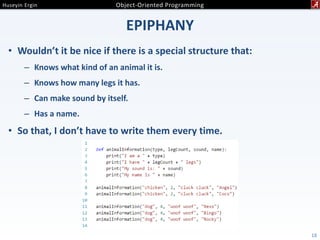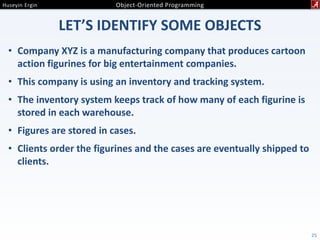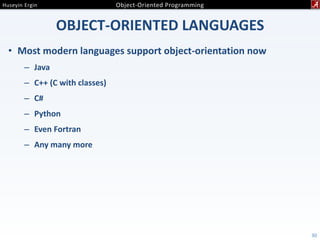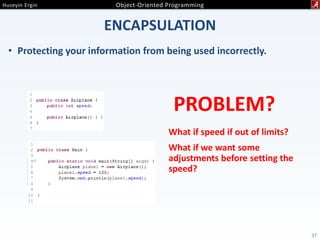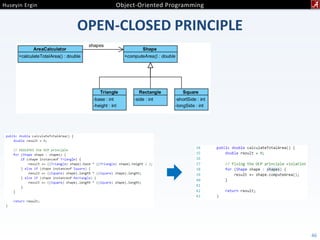Object oriented programming
- 2. PROGRAMMING? • Just writing some text in a specific format 2
- 4. SO, WHAT IS TRICK HERE? • A compiler/interpreter does the actual job! • Read text file, interpret the contents, output another file more understandable by machines, less understandable by us 4
- 5. MODERN IDES • Previous slide is not a modern day practice. – At least only computer engineers likes to do it. • Now we have IDEs (Integrated Development Environment) – Providing Text editors Compilers And many other useful features 5
- 8. WHAT IS A PROGRAM? • Just some sequential lines to instruct the computer what to do! 8
- 9. WHAT IS A PROGRAMMING LANGUAGE? • Provides the developer useful constructs – Defining variables – Looping – Conditionals – Many more… • And advanced constructs – Data management – Memory management – Networking – Scheduling 9
- 10. WHICH LANGUAGE • According to Google*: – The fastest language is C++ – BUT If you don’t optimize your code, you may end up slower than other languages – See C++ Dbg vs other languages 10*Loop Recognition in C++/Java/Go/Scala by Robert Hundt - Google
- 11. OF COURSE… • The programs are not small any more! – Chrome browser: 17 millions LOC (lines of code) – Office 2013: 45 millions LOC – Facebook: 60 millions LOC • You can’t just put all the lines sequentially and expect someone to understand! – First, it is impossible. – Second, it is torture. • Of course we need extra structures to handle the complexity 11
- 12. WHEN THINGS GET BIGGER - MODULARIZE 12 We can define methods in order to make our program mode readable.
- 13. MODULARIZE EVEN MORE 13 We can make this method parametric. And use parametrized version whenever needed.
- 14. FUN PART 14 Spoiler alert: You will see some code in action!
- 15. ENOUGH OF THE LINES, GIVE ME SOMETHING 15 I want to do this 3 times?
- 17. MODULARIZING – MORE PARAMETRIZED 17 We still have a lot of repetitions.
- 18. EPIPHANY • Wouldn’t it be nice if there is a special structure that: – Knows what kind of an animal it is. – Knows how many legs it has. – Can make sound by itself. – Has a name. • So that, I don’t have to write them every time. 18
- 19. EPIPHANY 19 So, we are basically talking about a dog? It has a name, knows how many legs it has, can make sound itself.
- 20. EPIPHANY • So we need to mimic the real life in our applications. • Because a program is for the developer to write/understand easily, not for the computer. 20*Author of the renowned Structure and Interpretation of Computer Programs book (with Jay Sussman) “First, we want to establish the idea that a computer language is not just a way of getting a computer to perform operations but rather it is a novel formal medium for expressing ideas about methodology. Thus, programs must be written for people to read, and only incidentally for machines to execute.” Harold Abelson*
- 21. EPIPHANY • Wouldn’t it be nice if there is a special structure that: – Knows what kind of an animal it is. – Knows how many legs it has. – Can make sound by itself. – Has a name. • We already have a system for this. – Object-oriented programming. A.k.a. – Object-oriented methodology – Object-oriented paradigm – Object-oriented design and analysis 21
- 22. OBJECT-ORIENTED PROGRAMMING • Basically, we have objects that know: – Its attributes – Its operations • Whenever, I need a square or triangle, I will use them. – I ask for information and they answer. 22 Side Area = side*side Side Height Base Area = (height*base)/2 height base
- 23. OBJECT IDENTIFICATION • Car, glass, bike, bus – All can be objects • Dog, cat, person, laptop – Again, can be objects • Running, walking, making a sound etc… ? – No, these are not objects! – These are actions (methods/operations) that can be done by an object Like a Rectangle can compute its own area A people can run. • Side, height, numberOfLegs etc… ? – No, these are not objects! – These are properties (attributes) that can be owned by an object Like side of a Rectangle. Numberoflegs of a Person. 23
- 24. EVERYTHING CAN BE AN OBJECT • It just depends on the context! • Distance between two cities can be an object – If it is the main focus of the problem. • Relationship between two people can be an object – If we are solving a problem about this. 24
- 25. LET’S IDENTIFY SOME OBJECTS • Company XYZ is a manufacturing company that produces cartoon action figurines for big entertainment companies. • This company is using an inventory and tracking system. • The inventory system keeps track of how many of each figurine is stored in each warehouse. • Figures are stored in cases. • Clients order the figurines and the cases are eventually shipped to clients. 25
- 26. OBJECTS IDENTIFIED • Company XYZ is a manufacturing company that produces cartoon action figurines for big entertainment companies. • This company is using an inventory and tracking system. • The inventory system keeps track of how many of each figurine is stored in each warehouse. • Figures are stored in cases. • Clients order the figurines and the cases are eventually shipped to clients. 26
- 27. ANY MORE? • Company XYZ is a manufacturing company that produces cartoon action figurines for big entertainment companies. • This company is using an inventory and tracking system. • The inventory system keeps track of how many of each figurine is stored in each warehouse. • Figures are stored in cases. • Clients order the figurines and the cases are eventually shipped to clients. 27
- 28. ANOTHER EXAMPLE • An ATM needs to allow a customer to identify themselves – Each customer has a debit card and PIN • Customers should be presented with some kind of menu to help direct them. • Customers can perform two transactions: – They should be able to deposit funds – They should be able to withdraw funds upto $200 These funds must be withdrawn in units of $20 • The ATM should tell some banking software to update the customers’ account at the end of transaction • The ATM should also give the customer some record of the transaction. 28
- 29. OBJECTS IDENTIFIED • An ATM needs to allow a customer to identify themselves – Each customer has a debit card and PIN • Customers should be presented with some kind of menu to help direct them. • Customers can perform two transactions: – They should be able to deposit funds – They should be able to withdraw funds upto $200 These funds must be withdrawn in units of $20 • The ATM should tell some banking software to update the customers’ account at the end of transaction • The ATM should also give the customer some record of the transaction. 29 This PIN number object seems redundant. We can make it a property of either customer or debit card. This small design decision will make a lot of difference.
- 30. OBJECT-ORIENTED LANGUAGES • Most modern languages support object-orientation now – Java – C++ (C with classes) – C# – Python – Even Fortran – Any many more 30
- 31. A REPRESENTATION SYSTEM • Various languages support object-orientation. • So, there should be a way to represent this system regardless of the language we use. • UML is here. 31
- 32. UML BASICS - CLASS 32 Side Area = side*side Side Height Base Area = (height*base)/2 height base
- 33. CLASS IN C# 33
- 34. WAIT • We were talking about objects, now what the heck is a class? • Time to define the relation between these two. • Basically, we get the properties that all the dogs have and define a Dog class with them. – A class is a generalization of objects. – And objects are just instances of the class. 34
- 35. OBJECTS FROM CLASSES • Constructor • Now we can create objects – From classes – Using a constructor 35
- 36. CONCEPTS & DESIGN PRINCIPLES IN OBJECT-ORIENTED PROGRAMMING • Concepts: – Encapsulation – Inheritance – Polymorphism – Cohesion – Coupling • Principles – Open-Closed Principle – Don’t Repeat Yourself Principle – Single Responsibility Principle – Liskov Substitution Principle – Interface Seggregation Principle – Dependency Inversion Principle 36 If we don’t use these concepts and obey these principles, we aren’t coding in proper object-oriented way.
- 37. ENCAPSULATION • Protecting your information from being used incorrectly. 37 PROBLEM? What if speed if out of limits? What if we want some adjustments before setting the speed?
- 39. INHERITANCE • A class’ inheriting properties and operations from another class. • Both Dogs and Cats have names, right? – Then, why shouldn’t we create a base class Animal for them? 39
- 40. POLYMORPHISM • Having different forms of same operations. 40
- 41. POLYMORPHISM 41
- 42. COHESION • A class should do one thing really well, and shouldn’t try to do or be someone else. • Strong cohesion means: all methods of a class are more or less related. – A Math class which can compute sqrt, power, exp, cos etc. • If a class has methods for: – Printing a document – Sending an email – Working with trigonometric functions – How should we name it? Complicated, right? 42
- 43. COUPLING • The extent to which classes depend on one another. – A class should work independently without being coupled too much to other classes. – This helps us making them modules and available on demand. 43
- 44. OPEN-CLOSED PRINCIPLE • Classes should be open to extension, but closed for modification. 44 PROBLEM? Whenever we add a new shape, we should modify the calculateTotalArea method.
- 47. DON’T REPEAT YOURSELF PRINCIPLE • Avoid duplicate code by abstracting common things out and placing them in a single location. 47
- 48. SINGLE RESPONSIBILITY PRINCIPLE • Every object in the system should have one responsibility – Each object has only one reason to change – Doesn’t mean it should only have one method • Usually the violation of this principle can be identified by asking: – Can _______ _________ itself? Example: Can Automobile changeTires itself? If it is no, it is violating SRP. 48
- 50. LISKOV SUBSTITUTION PRINCIPLE • Sub-classes must be substitutable for their base classes. – If you inherit from a wrong base class, then you can’t do this. 50 PROBLEM? We inherit from the board, but we hardly use its methods or properties. Because they don’t match with 3D board.
- 51. LISKOV SUBSTITUTION PRINCIPLE • Sub-classes must be substitutable for their base classes. – If you inherit from a wrong base class, then you can’t do this. 51 SOLUTION?
- 52. INTERFACE SEGGREGATION PRINCIPLE • A class should never be forced to have some unnecessary methods. 52 PROBLEM? We force Square to have a computeVolume method, which it doesn’t have!
- 54. DEPENDENCY INVERSION PRINCIPLE • Entities must depend on abstractions/interfaces rather than actual classes. – So that they can be decoupled. 54 PROBLEM?We have to treat each shape separately. Because we have links to actual classes.
- 56. WHAT CAN WE ACHIEVE FROM THIS? SOME IDEAS • Read data from various sources but our program can stay the same • Easily switch between different algorithms on the same data • Make any module work independent from others • Make the output of the project independent from the data or the algorithm itself • Test the correctness of each class independently • Model the problem in a human-readable way • And most importantly, reuse and maintain your application better. – Future-proof. 56
- 57. OTHER TOOLS & TECHNOLOGIES IN ORDER TO IMPROVE YOUR PROGRAMMING • Versioning (github, bitbucket etc.) – Version your code in order to access any change you made (and backup) • Unit tests – Test each unit independently, be sure it is doing whatever it is supposed to do. – Most languages have support for this. Look for it. • Documentation (Doxygen, Javadoc etc.) – Always comment your code. You can even produce automatic documentation from these comments. • Diagramming – Your code may not be understandable, but your diagrams will be. Learn UML Class diagram and use it in your projects. 57
- 58. CONCLUSION • Object-oriented programming provides very flexible structures for our programs. – It can be applied in many languages, as long as the language supports object-orientation. • If we obey the principles, it will be an actual system. – Otherwise, it is just the same code with classes and additional complexity. • Object-oriented system is not a perfect system and it has its own flaws. But it is still the best system. • Always strive for the best design. 58
- 59. QUESTIONS? • Thanks for listening… • For offline questions, find my contact info here: www.objectivelook.net 59
- 60. SOME RESOURCES • Object-oriented programming with C# (The book itself is nice and free, chapter 20 is OOP): http://www.introprogramming.info/english-intro- csharp-book/read-online/ • For new starters to OOP, this book is fun: https://www.amazon.com/Head-First-Object-Oriented-Analysis- Design/dp/0596008678 • Detailed explanation, nicely done, 2 pages (Java): – https://www.ntu.edu.sg/home/ehchua/programming/java/J3a_OOPBasics.ht ml – https://www.ntu.edu.sg/home/ehchua/programming/java/J3b_OOPInheritan cePolymorphism.html • Same as above but with C++: – https://www.ntu.edu.sg/home/ehchua/programming/cpp/cp3_OOP.html • Even though, there are a lot of resources. I suggest to work with someone who you can ask questions immediately. Because OOP requires a change of mindset. 60


















